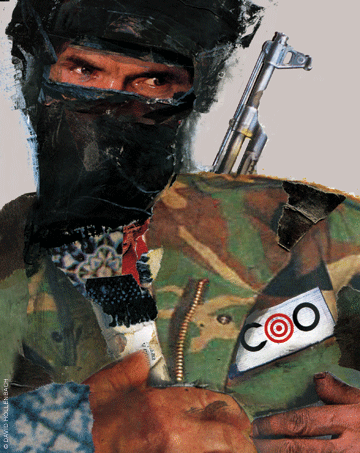
How America’s secret hunt for al Qaeda’s No. 3 transformed the struggle against terrorism.
By Aki Peritz | An organization that loses its chief operating officer has lost a critical decision-maker. Any good Wharton grad can tell you that. But few people realize that what’s true for a multinational corporation also holds for a transnational terrorist network.
The story of how US Navy SEALs killed Osama bin Laden is widely known. Less well appreciated is the impact of America’s evolving campaign against bin Laden’s COOs. The secret efforts to eliminate these little-known men are some of the great unsung stories of the last decade.
As my coauthor Eric Rosenbach and I detail in Find, Fix, Finish: Inside the Counterterrorism Campaigns that Killed bin Laden and Devastated al Qaeda, these operational commanders—the No. 3 men, in common parlance—are essential to carrying out spectacular attacks like 9/11. By charting their lives and their deaths over the last decade, we can also trace how America has both succeeded and failed in confronting the thorny, ethically complex problems that have arisen in this conflict.
Al Qaeda’s first operational commander to die was killed almost by accident. In the chaotic months following the 9/11 attacks, the US launched conventional airstrikes against targets throughout Afghanistan in an effort to destroy Taliban defenses all over the country. One of these sorties struck a multi-story structure outside of Kabul where longtime al Qaeda commander Muhammed Atef—a former Egyptian policeman who had been waging some form of jihad for three decades—was meeting with Taliban officials. Only after America intercepted communications indicating he had been killed in the blast did the US identify him and understand his specific role within al Qaeda. And while defeating this foe was a clear victory, America also realized that Atef and other COOs would possess intelligence critical for planning future operations.
As a result of America’s efforts in Afghanistan, al Qaeda fled across the southern border into Pakistan. So the conflict changed, and the US swapped the sledgehammer for the scalpel to hunt al Qaeda’s top operatives in Pakistan’s teeming cities. This counterterrorism effort required a close alliance with Pakistan’s intelligence and military services. In 2003, with significant American assistance, Pakistani security officials led a charge that captured operational commander (and 9/11 mastermind) Khalid Shaykh Mohammed. These combined efforts also snagged his COO successor, Abu Faraj al-Libi, a few years later. Both are now in Guantanamo Bay.
At the same time, major legal and ethical conundrums quickly multiplied as America began to detain hundreds of suspected terrorists. In the headlong rush to destroy al Qaeda, US policymakers made short-term choices at the expense of long-term planning—including utilizing harsh tactics to elicit information during interrogation, holding prisoners in so-called “black sites,” and perhaps most troubling, creating a legally muddled doctrine of holding detainees until the “end of hostilities.” Much to the current White House’s chagrin, many of these challenges are far from being solved any time soon.
With the recognition of No. 3’s importance came a sometimes troubling zeal to capture known leaders within the organization and extract meaningful intelligence.
In 2002, America tried to balance improving the quantity of actionable intelligence gained through interrogation with immediately killing top al Qaeda operatives. For example, US officials determined that a Palestinian who used the nom de guerre Abu Zubaydah was a big fish in al Qaeda—what President Bush called “one of the top three leaders” in the group. In 2002, US and Pakistani officers captured Abu Zubaydah, but soon after his arrest, some officials believed that he was withholding valuable information. US government employees then successfully petitioned the Bush White House and the Department of Justice to allow them to take “enhanced” measures they felt appropriate to extract the information needed to stop the next attack. In the effort to elicit more intelligence, according to Abu Zubaydah’s defense counsel, CIA officers took him to a so-called “black site”; he was beaten, suspended from hooks drilled into the ceiling, locked in a confining box for hours at a time, kept awake for days, and finally waterboarded 83 times. The current attorney general in his confirmation hearings would later unambiguously call the last technique “torture.”
After exhausting the list of coercive interrogation techniques, US officials began to realize that Abu Zubaydah was not actually as important as they had originally thought. Eventually, the US determined that he was hardly a terrorist mastermind—and not even officially part of al Qaeda—but rather more of a jihadist travel agent. This gradual revelation indicates that the US has at times had limited insight into the identity of al Qaeda’s COO, highlighting both the perils of acting upon poor intelligence and the cost to America’s image when we harshly treat our detainees.
By mid-decade, US policymakers decided that taking top leaders off the battlefield by killing them trumped the loss in strategic and tactical intelligence gleaned from interrogation. This shift was buttressed by enhancements in America’s technical ability to surveil and target key figures via armed Unmanned Aerial Vehicles, and by the fact that many of these individuals had fled to areas in Pakistan beyond Islamabad’s writ, making risky capture operations just about impossible. Killing operational commanders also solved the increasingly frustrating question of what to do with these leaders once they were captured.
The new drone war—which according to The New York Times and other publications was waged with the knowledge of the Pakistani military and intelligence hierarchies, despite self-serving protestations to the contrary—became the key method to batter al Qaeda’s core leadership into oblivion. This blunt solution is not without its own inherent ethical conundrums; launching deadly strikes on perceived terrorists used to be a practice America was quick to question other countries for pursuing, even criticizing Israel for its lethal counterterrorism actions as late as May 2001. Yet this tactic has been remarkably successful in pursuing al Qaeda’s No. 3 and keeping the organization off-balance.
Most of al Qaeda’s operational commanders, scores of lesser al Qaeda and Taliban personnel, and, unfortunately, a number of unlucky civilians, met their ends this way. The COOs killed in the latter half of the decade were indeed hardcore longtime militants, like Abu Hamza Rabia (who died in December 2005), Abu Layth al-Libi (January 2008) and Usama al-Kini (January 2009). In fact, the only No. 3 who avoided this fate was a bombmaker named Abu Ubaydah al-Masri, who died in late 2007 from complications after contracting Hepatitis C.
These lethal efforts clearly strained al Qaeda’s capacity to field competent leaders. As strikes ravaged the organization’s personnel, the group increasingly promoted individuals with little battlefield experience. At one point al Qaeda was forced to put its accountant, Shaykh Sa’id al-Masri, in command, before the US killed him in May 2010. Following his demise, a Libyan named Atiyah Abd al-Rahman—bin Laden’s crotchety friend who served as an interlocutor with other jihadist groups—held the post until America caught up with him in August 2011.
The US is well on its way to grinding al Qaeda in South Asia into the history books. This effort has hardly been accomplished with kid gloves, but it has brought a fearsome organization to its knees. “I’m convinced,” Secretary of Defense Leon Panetta said last summer, “that we’re within reach of strategically defeating al Qaeda.” While some of its global franchises continue to menace the US, such as al Qaeda in the Arabian Peninsula, the parent organization is struggling to stay afloat in the face of a relentless, unforgiving American counterterrorism effort. Ruthlessly targeting al Qaeda’s No. 3 has been one of the keys to that success.
Of course, killing one al Qaeda leader or even a dozen will not fully undermine the group; its utopian ideology needs to be defeated as well. As Michael Vickers, the bookish fellow in Charlie Wilson’s War who now serves as the under secretary of defense for intelligence, recently noted, “You still have al Qaeda, the idea.”
Beyond the how of drones or elite soldiers, America needs to continually reestablish why we battle this group, both to keep al Qaeda on the ideological defensive as well as underscore to our allies—and ourselves—that fighting this organization remains a worthwhile endeavor.
These larger strategic efforts seem to be bearing fruit. Bin Laden at one point considered changing al Qaeda’s name, especially since US officials “have largely stopped using the phrase ‘the war on terror,’” according to the White House’s top counterterrorism official, John Brennan. By keeping a white-hot focus on destroying al Qaeda (and not by playing into the organization’s narrative that the US is at war with Islam) America can finally eradicate the root as well as the branch. We may never fully deter those who use terrorism to accomplish their goals, but we can make the price for engaging in such behavior prohibitively high.
Who is al Qaeda’s current COO? I’ve been told that the group has given up placing all this responsibility into one man’s portfolio, preferring to delegate tasks to multiple people. Without an overall operational commander guiding its missions, al Qaeda’s ability to execute tightly coordinated terrorist strikes—their signature calling card—becomes further degraded. What remains of al Qaeda’s core leadership seems to have realized that having someone fill the COO slot is a surefire way to elevate their best people to the top of America’s target list.
Aki Peritz C’01 is a former CIA counterterrorism analyst and the current senior national security advisor to the Third Way think tank. He is the author, with Eric Rosenbach, of Find, Fix, Finish: Inside the Counterterrorism Campaigns that Killed bin Laden and Devastated al Qaeda (PublicAffairs, 2012).




